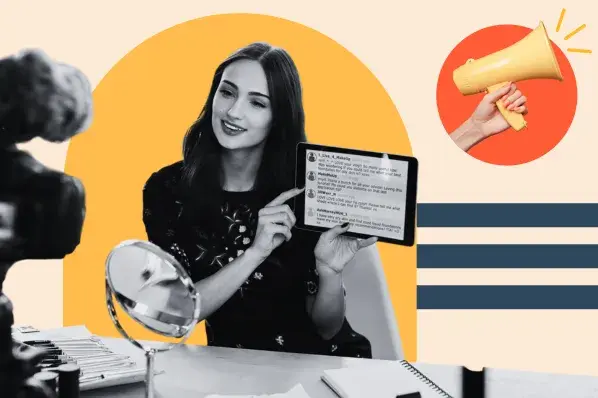But I wasn't convinced these influencers had my best interest in mind. Yes, most influencers' (and micro-influencers) are successful because they promote valuable products. But they're getting commission off those posts, too.
So I handled my problem the old-fashioned way — I texted my friends and asked what products they use.
This isn't to say influencer marketing is ineffective. Quite the opposite: When done right, influencer marketing is a fantastic opportunity to expand your brand's reach and increase sales.
But depending on your team's budget, influencer marketing could be limiting. Plus, influencer marketing inhibits your brand from reaching those consumers who still trust their peers above all else.
Enter: P2P marketing.
Why is peer-to-peer marketing effective?
Given 93% of consumers trust friends and family over all other influences (including review sites, blogs, and social media platforms), it makes sense why P2P marketing works.
And P2P marketing, a form of word-of-mouth marketing, isn't new. People have been giving personal opinions about their favorite — and least favorite — brands, products, and services long before social media.
If you're learning about P2P marketing for the first time, you might be wondering — why invest in P2P marketing, instead of more traditional forms of influencer marketing?
And what's the difference, anyway?
Why Peer-to-Marketing Is Simply Better
Over the past couple of years, influencer marketing has been one of the most popular and effective opportunities for brands to reach new audiences by leveraging those influencers' built-in communities.
However, as mentioned above, consumers still trust their own peers more than anyone else. And influencers can often feel like celebrities to the general public — in fact, sometimes, they are actual celebrities, like George Clooney with Nespresso. This removes a level of authenticity you might be striving for as a brand.
Additionally, many small and medium-sized businesses can't afford the typical influencer cost. Celebrity or macro-influencers charge between $3,000 and $500,000 for a single post — and while micro-influencers are undoubtedly cheaper, they can also charge upwards of $500 per post.
Ultimately, P2P is a form of marketing that can feel increasingly trustworthy and authentic through real, genuine reviews from peers who have no incentive to promote businesses they don't care about.
To further explore the difference between P2P marketing and influencer marketing, let's consider an example.
Peer-to-Peer Marketing vs Influencer Marketing Example

Briogeo, a haircare company, has a referral program in which they credit existing customers 500 points for each invited friend who makes a purchase. This is an example of P2P marketing.
Briogeo’s influencer marketing campaign, on the other hand, refers to the influencers on Instagram (as well as other social platforms) who tag posts with #briogeoambassador, signifying the post is sponsored by Briogeo.
These are both equally valuable marketing options, but they achieve different goals. Briogeo’s P2P marketing initiative (in this case, the referral program), aims to tap into the company’s existing consumers to reach new prospects.
The company’s P2P program is likely more narrow in reach, but has the potential to convert more quickly than influencer marketing, since it's leveraging the power of an existing relationship between customers and their friends or family. The influencer marketing program, alternatively, is meant to spread brand awareness about Briogeo to a wider audience.
How to Start Peer-to-Peer Marketing
You can increase P2P marketing by selling a fantastic product that your customer can’t help but recommend to others. But even if you do have a fantastic offering, it’s not guaranteed that your customers will recommend them to their family and friends.
Here’s how to prompt P2P marketing the organic way.
1. Ask for customer reviews and recommendations — always.
Some older forms of P2P marketing include Yelp, reviews on personal business' websites, and good old-fashioned conversations between your consumers and their friends and family. You can still take advantage of these traditional avenues by asking for customer reviews and recommendations. Even if a customer doesn’t post a review online, they may feel compelled to share the product with those around them just by having that reminder.
2. Leverage referral marketing tools to increase peer-to-peer word-of-mouth.
You don’t have to rely on luck and hope that your customers will recommend your products and services. You can prompt them to do so using new tools to leverage P2P marketing on a broader scale.
Geniusreferrals, for instance, helps businesses generate customer reviews and referrals, guarantee event attendance, or even increase in-store foot traffic. The tool ultimately relies on the premise of P2P marketing: That there's nothing more powerful than peer recommendations.
Other tools, like Higher Logic, work to establish a sense of community among existing consumers, and increase brand loyalty — a critical component of P2P marketing. (Since consumers won't refer products or services towards which they don't feel loyal.)
Peertomarketing.co has an excellent directory of P2P marketing tools for any budget and company size.
3. Carry out NPS® surveys to find out how your customers feel about you.
Finding out how your customers feel about your product is instrumental for increasing peer-to-peer marketing. While you could carry out a traditional survey with many questions, you can capture your customer’s sentiment by asking the classic Net Promoter Score question:
“On a scale of 0 to 10, how likely are you to recommend us to a friend?"
The moment you know your NPS score, you can implement strategies to increase it — and find out what, if anything, is preventing your customers from recommending your business or product to their peers.
4. Incentivize referrals by offering discounts and freebies to your customers.
While customers don’t trust influencer marketing because they know influencers get commission, the same effect doesn’t apply when it comes to their peers. Even if you offer account credit or free products in exchange for a referral, your customer’s identity as a friend or peer will be enough to sway the referred customer to make a purchase.
After all, you wouldn’t just recommend any product to your friends and families in exchange for a discount, especially if that product doesn’t work for you. But by referring other customers, your customer is giving you a vote, making it easy for others to accept the referral and make a purchase.
Peer-to-Peer Marketing Is a Winning Marketing Strategy
P2P marketing can take different forms depending on your brand and business goals. You can create a referral program, encourage reviews on your site in exchange for a small discount or prize, or organize events meant to increase brand awareness to the larger community.
Ultimately, P2P marketing comes down to increasing the incentive for your consumers to share your product or service with friends and family, which is undoubtedly one of the best long-term strategies for success.
Editor's note: This post was originally published in March 2021 and has been updated for comprehensiveness.
Influencer Marketing



.jpg)



![Influencer Marketing Strategy: How to Build a Plan Creators & Customers Will Love [+ Templates]](https://53.fs1.hubspotusercontent-na1.net/hubfs/53/influencer-marketing-strategies-featured.png)

-1.png)
.webp)

